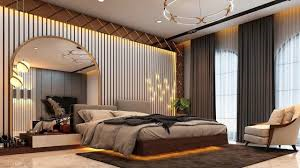Designing a bedroom involves balancing aesthetics, comfort, and functionality. Here’s a detailed guide on how to design a bedroom:
1. Determine Your Style
- Identify Your Preferences: Decide on the overall style of your bedroom. Common styles include modern, minimalist, traditional, bohemian, rustic, and contemporary. Look for inspiration in magazines, online platforms like Pinterest, or interior design blogs.
- Color Palette: Choose a color scheme that reflects your style and personality. Soft, neutral colors like whites, beiges, and grays create a calm environment, while bold colors like deep blues or rich greens can make a statement.
2. Plan the Layout
- Assess the Space: Measure your bedroom and make note of any architectural features like windows, doors, or built-in wardrobes. This will help you plan the placement of furniture.
- Bed Placement: The bed is the focal point of the bedroom. Position it against the longest wall or under a window if possible. Ensure there’s enough space on both sides for nightstands.
- Furniture Arrangement: Arrange other furniture like dressers, chairs, or desks according to the room’s size. Avoid overcrowding; less is often more in bedroom design.
3. Choose the Right Furniture
- Bed and Mattress: Invest in a comfortable bed and mattress, as these are key to good sleep. The bed frame should match your style—think upholstered for a luxurious feel, or wood for a rustic vibe.
- Nightstands: Select nightstands that complement your bed. They should be at a comfortable height and provide enough storage for bedside essentials.
- Storage Solutions: Incorporate storage solutions like wardrobes, dressers, or under-bed storage. Custom or built-in wardrobes can maximize space in smaller rooms.
4. Lighting
- Layered Lighting: Use a mix of ambient, task, and accent lighting. Overhead lights provide general illumination, bedside lamps or sconces offer task lighting, and accent lighting can highlight features like artwork.
- Natural Light: Maximize natural light by choosing light window treatments like sheer curtains or blinds. Mirrors can also reflect light and make the room feel larger.
5. Decor and Accessories
- Bedding and Textiles: Choose bedding that is both comfortable and stylish. Layer with pillows, throws, and blankets in complementary colors and textures.
- Wall Decor: Consider adding artwork, mirrors, or decorative wall hangings that match your style. A feature wall with wallpaper or a bold paint color can add interest.
- Rugs: A rug under the bed can add warmth and texture. Ensure it’s large enough to extend beyond the sides and foot of the bed.
- Personal Touches: Add personal touches like family photos, plants, or meaningful objects that make the space feel like your own.
6. Focus on Comfort
- Temperature Control: Ensure the room has good ventilation and consider using fans, air conditioning, or heating to maintain a comfortable temperature.
- Noise Reduction: Use thick curtains, carpets, or soundproofing materials to reduce noise and create a peaceful environment.
- Scent: Incorporate calming scents like lavender or vanilla through candles, essential oils, or diffusers to enhance relaxation.
7. Keep it Clutter-Free
- Organize: Keep surfaces clear and only display items that are necessary or decorative. Regularly declutter to maintain a serene atmosphere.
- Storage: Use baskets, trays, or boxes to organize smaller items like jewelry, books, or electronics.
8. Final Touches
- Review: Step back and review your design. Ensure that the room feels balanced, with a good mix of colors, textures, and functional spaces.
- Adjust: Make any necessary adjustments to lighting, furniture placement, or decor to enhance the overall feel of the room.
By following these steps, you can create a bedroom that is not only beautiful but also a comfortable retreat tailored to your personal style.







Leave a Reply